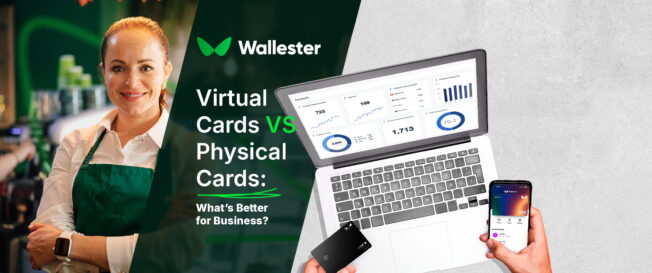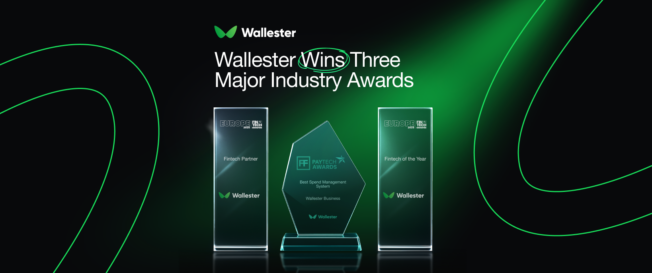Choosing how to pay for things is no longer a simple matter for most companies. As more businesses move online and teams become more remote, the decision between using virtual or physical cards has become much more important. Each option comes with its own set of strengths, trade-offs, and specific use cases. Understanding how they differ and what each one offers can help you build smarter payment processes and keep better control over everyday spending.
Key Takeaways
- Virtual cards give businesses more control and reduce the risk of fraud by using unique numbers and custom limits.
- Physical cards still offer the widest acceptance and allow for cash withdrawals when needed.
- Digital payment methods are changing how companies handle day-to-day spending.
- The right choice depends on what your company spends money on and how those payments are made.
What is a Virtual Card?
A virtual card is a digital-only version of a payment card that you can use online or through mobile apps. It’s not something you can hold in your hand, but it works just like a regular card – with its own number, expiration date, and security code. These cards are linked to your main account and give you an extra layer of protection when making digital payments.
They’re especially useful for more than just quick online purchases. Businesses often turn to virtual cards because they can set spending limits, track transactions in real time, and create separate cards for different teams or purposes. It’s a flexible, secure way to manage expenses without relying on physical cards.
What is the process of issuing virtual cards?
The process of getting a virtual card is simple and fast. Most banks and financial platforms let you generate one directly through their website or mobile app. Business users usually log in to their account, request a new virtual card, and receive the full card details including number, expiry date, and security code within minutes.
Each card is created with a unique set of numbers and connects straight to the main business account. It can be used right away for online purchases or digital payments. There is no need to wait for printing or delivery by mail. Since everything happens online, virtual cards are a practical choice for companies that need quick and secure ways to pay.
The Advantages of Virtual Cards
Virtual cards come with a range of advantages that have made them a go-to choice for many modern businesses.
Security and control benefits:
- They offer extra protection by using unique card numbers for each transaction or vendor.
- You get detailed records for every payment, plus the ability to monitor spending in real time.
- It’s easy to set spending limits and define how and where each card can be used.
- The risk of fraud is much lower than with traditional cards.
Further Reading: Virtual Card Fraud Prevention: How Secure Are They?
Operational efficiency:
- You can create them instantly without having to wait for anything in the mail.
- They’re great for handling subscriptions and regular payments.
- Tracking business travel costs and online purchases becomes much easier.
- You can also use them with mobile wallets like Apple Pay and Google Pay.
One of the biggest differences between virtual and physical cards shows up in how they handle security. Virtual cards can be set up for specific vendors, spending limits, or even time windows. That kind of flexibility gives companies more control and helps avoid unauthorised spending.
The Downsides of Virtual Cards
Even though virtual cards offer a lot of advantages, there are still some limitations businesses need to think about. One of the main issues is that you cannot use them to withdraw cash from ATMs or cash machines. That can be a problem for companies that need regular access to cash as part of their daily operations.
Another limitation is related to acceptance. Not all point-of-sale terminals or in-store systems are ready for digital payments. Some older technologies or smaller businesses may not support virtual card transactions, which makes them less practical for face-to-face purchases or physical locations that rely on more traditional payment setups.
What is a Physical Card?
A physical card is the classic form of payment most people are familiar with. It’s the plastic card you can carry in your wallet and use just about anywhere. These cards come with embedded chips, magnetic stripes, and printed details like your name, card number, and expiration date. You can use them for both in-store purchases and online transactions, and they connect directly to your bank account.
Both credit and debit versions of physical cards are widely accepted and easy to use, which is why so many businesses and customers still rely on them. Having the card in hand adds a sense of security during transactions, and being able to see and verify the card details right away can be reassuring, especially in face-to-face situations.
What is the process of issuing physical cards?
Getting a physical card usually takes longer than receiving a virtual one. Most financial institutions need several business days to handle the entire process, which includes manufacturing and delivery through postal services. It starts with account verification, after which the card issuer begins creating the physical plastic card. This includes embedding the necessary security features, printing personalised information, and packaging the card for secure shipment.
The total time required for this process usually ranges from three to ten business days, depending on the bank and your delivery location. For businesses that plan to use physical cards, it is important to take this timeframe into account, especially when scheduling rollouts, managing cash flow, or preparing for new employee onboarding.
The Advantages of Physical Cards
Physical cards offer clear advantages that make them a regular part of many business operations:
Universal acceptance and flexibility:
- Work at all point-of-sale terminals and cash machines
- Allow cash withdrawals when needed
- Accepted in most countries without depending on newer technology
- Useful as a backup when digital systems are unavailable
Practical business applications:
- Well-suited for in-store purchases and face-to-face transactions
- Helpful for covering travel costs and expenses abroad
- Work with contactless payment systems
- Useful for businesses that need to check payment methods in person
The main strengths of physical cards are their dependability and wide acceptance. Unlike virtual cards, they function reliably in nearly any payment setting, which makes them a good fit for companies that need a range of payment options.
The Downsides of Physical Cards
Physical cards come with a few drawbacks that are worth keeping in mind. One of the biggest concerns is security – if a card gets lost or stolen, there’s a risk it could be misused before you have a chance to block it. Unlike virtual cards, which can be limited to certain merchants or amounts, physical cards usually offer broader access, which makes them harder to control.
There are also other inconveniences. Replacing a lost or damaged card takes time, which can slow things down. And unlike virtual cards, physical ones don’t allow for fine-tuned spending controls. They also don’t offer detailed tracking or real-time updates, so keeping tabs on expenses can become more time-consuming.
Key differences between virtual and physical cards
The most noticeable difference between virtual and physical cards is how they are used and where they work. Virtual cards exist entirely online and are ideal for internet-based transactions such as software subscriptions, online purchases, and payments made by remote teams. Physical cards are the plastic ones you can hold in your hand, and they work in almost any setting, whether you’re shopping online, paying in-store, or withdrawing cash at an ATM. This basic difference shapes the strengths and limitations of each type.
Security is another area where they differ. Virtual cards often come with added layers of protection. You can set limits for specific merchants, timeframes, or spending amounts, which helps lower the risk of fraud. Physical cards rely on standard security features like chip technology and PIN codes. While these are effective, they do not offer the same level of control. In terms of where you can use them, physical cards are more versatile since they are widely accepted in both digital and physical environments. Virtual cards work well for online payments but might not be accepted in places that still rely on older systems or in situations where a physical card is required.
Further Reading: The Complete Guide to Virtual Cards for Business

Types of virtual and physical cards
Both virtual and physical cards come in different forms to suit a variety of business needs. Choosing the right type depends on how you plan to use them and what kind of control or flexibility you require.
Virtual cards can be issued for different purposes:
- Virtual credit cards are linked to a credit line, making them suitable for larger purchases or managing cash flow.
- Virtual debit cards are connected to a business account, giving you real-time access to available funds.
- Prepaid virtual cards are loaded with a fixed amount and are often used for specific teams, projects, or departments where spending needs to be limited.
Physical cards also offer a range of options:
- Physical credit cards allow businesses to borrow against a credit line and often come with perks like cashback or reward points.
- Physical debit cards are tied directly to your account balance and are useful for day-to-day purchases.
- Corporate cards are issued to employees and come with built-in expense tracking and reporting features, helping finance teams manage budgets and compliance.
Each card type has its own strengths and fits into different business strategies, whether you’re looking for spending control, flexibility, or simplified expense management.
When do you use virtual cards?
Virtual cards are especially useful when your business deals with digital transactions. They’re a smart choice for things like online shopping, software subscriptions, or any recurring payments tied to specific services. Since each card can be issued with its own spending limits and merchant rules, they help prevent overspending and reduce the risk of misuse.
They’re also a great fit for managing employee expenses, especially for remote teams or departments that need their own spending tools without the need to hand out physical cards. If your company regularly pays for digital advertising, cloud services, or freelancer work, virtual cards offer the flexibility to create dedicated cards for each purpose. You can explore more detailed examples in our article on the Top Use Cases for Virtual Cards in Business.
Another major advantage is how fast they’re issued. You don’t need to wait for a card to arrive in the mail. You can generate a new virtual card in minutes and use it immediately, which is helpful when unexpected purchases come up or when onboarding new employees or vendors. This kind of instant control makes virtual cards a reliable and secure way to manage payments for businesses that need flexibility without losing track of their spending.
Tips on how to use virtual cards efficiently
Maximising virtual card efficiency requires strategic implementation and proper management practices:
Setup and management:
- Create separate virtual cards for different expense categories
- Set appropriate spending limits for each card purpose
- Monitor detailed transaction data regularly
- Use virtual cards for all recurring payments and subscription services
Security best practices:
- Generate unique card numbers for each merchant relationship
- Implement transaction limits based on expected spending patterns
- Review and update virtual card permissions regularly
- Integrate virtual cards with your digital wallet for streamlined payments
Businesses can make the most of virtual cards by setting up separate cards for different needs, like travel, marketing, or supplier payments. Managing expenses this way gives teams clearer oversight and makes it easier to track where the money is going, compared to relying on just one payment method.
When do you use physical cards?
Physical cards are still important when cash is needed or when payments happen face-to-face. They are useful for ATM withdrawals, in-store purchases where digital payments are not accepted, and travel situations where reliability matters.
Many companies also keep physical cards as a backup, especially for international trips or when dealing with merchants who still use traditional systems. Their wide acceptance makes them a steady part of how most businesses handle payments.
Tips on how to use physical cards efficiently
To get the most out of physical cards, companies need to set clear rules and keep a close eye on how the cards are used:
Security and control measures:
- Implement company policies for physical card usage
- Require receipts and documentation for all transactions
- Set monthly spending limits with your financial institution
- Monitor statements regularly for unauthorised activity
Operational efficiency:
- Designate specific cards for different business functions
- Train employees on proper card handling and security procedures
- Maintain records of card numbers and expiry dates
- Plan for card replacement before expiry dates
While managing physical cards takes more hands-on effort than virtual ones, they still play an important role in day-to-day operations when handled properly.
Are virtual cards better than physical cards?
The answer depends on how your business manages its expenses. Virtual cards are a strong option for online transactions, recurring payments, and situations that require tighter control. They are quick to issue, easy to manage, and give you clear visibility into spending.
Physical cards, on the other hand, are still important for in-person purchases, cash withdrawals, and working with merchants that do not support digital payments. Many companies choose to use both, assigning virtual cards for specific online needs and relying on physical cards where a traditional payment method is more practical.
Virtual Cards vs. Physical Cards: Case Studies
Case Study 1: Technology Startup
A software company implemented virtual cards for all online payments and subscription services. The team used virtual cards for cloud computing services, marketing tools, and freelancer payments. This approach reduced fraud incidents by 85% and improved expense tracking accuracy. However, they maintained physical cards for office supplies and client entertainment expenses.
Case Study 2: Retail Business
A retail chain adopted a hybrid approach, using virtual cards for online inventory purchases and digital marketing campaigns while maintaining physical cards for in-store supplies and cash deposits. The combination provided optimal security for online transactions and practical flexibility for operational needs.
Case Study 3: Consulting Firm
A professional services firm issued virtual cards to consultants for travel expenses and client-related purchases. The detailed transaction data and spending controls reduced expense report processing time by 60%. Physical cards remained necessary for cash advances and international travel where digital payments weren’t universally accepted.
Wallester as a Trusted Payment Provider for Growing Businesses
Wallester provides a complete set of tools for managing business payments. As a Visa principal member, it can issue both virtual and physical cards directly, giving companies faster access to customised card programmes without relying on intermediaries.
Through the Wallester platform, teams can instantly issue virtual cards for online payments or subscriptions, while also ordering physical cards for travel, cash access, or face-to-face purchases. This flexibility allows businesses to tailor their payment approach to match different situations without switching between providers.
What sets Wallester apart is its focus on control and clarity. The platform includes real-time transaction tracking, detailed spending limits, and built-in security settings across all card types. These features help companies stay on top of their expenses and reduce the risks that come with uncontrolled spending.For companies that want to keep payments organised and adaptable, Wallester offers a practical solution with the structure and support to scale alongside your operations. You can learn more about the offering on the Wallester Business page.


